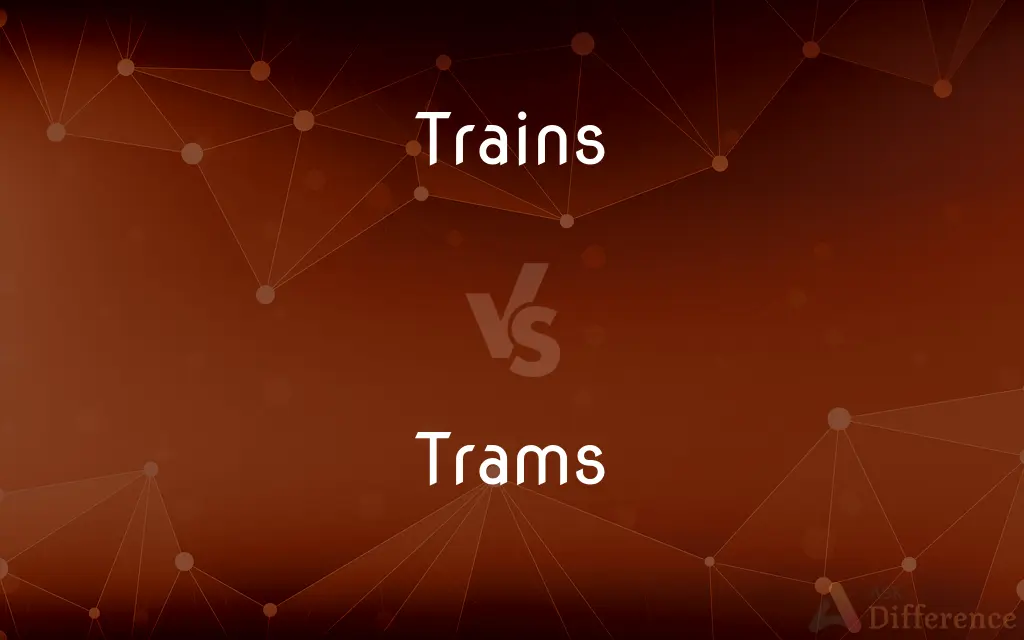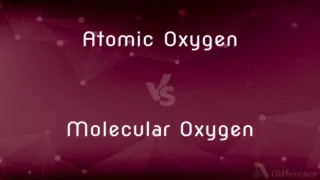Trains vs. Trams — What's the Difference?
Edited by Tayyaba Rehman — By Fiza Rafique — Published on March 3, 2024
Trains are heavy rail vehicles running on dedicated tracks, often for long-distance travel between cities, whereas trams, known as streetcars, operate on urban tracks, sharing city streets with other vehicles, focusing on shorter, stops within cities.

Difference Between Trains and Trams
Table of Contents
ADVERTISEMENT
Key Differences
Trains are designed for high-speed, long-distance travel, carrying passengers or freight across regions or countries on exclusive railway lines. They are characterized by their ability to handle a high volume of passengers or goods, making them suitable for intercity travel and heavy freight transportation.
Trams, in contrast, serve as an urban public transport system, running on tracks that are embedded in city streets, providing frequent stops and connecting various parts of a city or its suburbs. This makes trams an integral part of the urban transit system, facilitating short-distance travel with ease of access.
One of the key differences lies in the infrastructure required for each. Train operations necessitate a comprehensive network of railway tracks, stations, and signaling systems to manage long-distance routes efficiently. Trams require a less extensive infrastructure, with tracks laid along urban roads and lighter signaling equipment, allowing them to blend with city traffic and pedestrian areas seamlessly.
Trains offer faster speeds and higher capacity, suited for long-haul routes, whereas trams are optimized for accessibility and short, frequent journeys. The operational speed of trains is significantly higher than that of trams, which move at lower speeds due to their integration into urban traffic and the need for frequent stops.
From an environmental and urban planning perspective, trams contribute to reducing urban congestion and pollution by providing a reliable and efficient alternative to personal vehicles. Trains, while also environmentally friendly compared to road transport, play a crucial role in reducing long-distance road traffic and air travel, contributing to a decrease in overall carbon emissions.
ADVERTISEMENT
The choice between trains and trams is dictated by the distance to be traveled and the specific transportation needs. Trains are preferred for longer distances where speed and capacity are critical, while trams are favored for short to medium distances within urban and suburban areas where frequent stops and integration with the urban landscape are important.
Comparison Chart
Primary Use
Long-distance travel and freight
Short-distance, urban transit
Infrastructure
Dedicated railway tracks and stations
Tracks embedded in city streets
Speed
High-speed for long distances
Lower speeds, frequent stops
Capacity
High passenger or freight capacity
Lower capacity, designed for frequent boarding
Route Length
Long routes between cities or regions
Shorter routes within cities or suburbs
Integration with Urban Traffic
Separate from urban traffic
Integrated with city traffic
Environmental Impact
Reduces long-distance road and air traffic
Reduces urban congestion and pollution
Operational Focus
Efficiency in long-haul transport
Accessibility and convenience in urban areas
Compare with Definitions
Trains
Trains transport passengers or freight across long distances efficiently.
The express train from New York to Washington D.C. offers a quick alternative to driving.
Trams
Trams provide convenient urban transit with frequent stops.
The downtown tram makes it easy to hop between shops and offices.
Trains
They run on dedicated railway lines.
High-speed trains use specialized tracks for faster travel times.
Trams
They share roads with other vehicles.
Trams navigate through city traffic, stopping at regular intervals.
Trains
Suited for intercity travel.
Many commuters rely on trains for their daily travel to the city.
Trams
Enhance urban mobility and reduce congestion.
The tram system has significantly cut down on city traffic and pollution.
Trains
Offer high capacity and speed.
The bullet train can carry thousands of passengers at speeds over 200 mph.
Trams
Ideal for short to medium city journeys.
Residents use trams for quick access across the city without using a car.
Trains
Separate from urban traffic.
Train tracks bypass urban congestion, offering a smooth journey.
Trams
Embedded tracks in urban areas.
Tram tracks are laid directly into the city streets, blending with traffic.
Trains
A series of connected railroad cars pulled or pushed by one or more locomotives.
Trams
A streetcar.
Trains
A long line of moving people, animals, or vehicles.
Trams
A streetcar line.
Trains
The personnel, vehicles, and equipment following and providing supplies and services to a combat unit.
Trams
A cable car, especially one that rolls along an overhead cable along which it is drawn by a second, moving cable.
Trains
A part of a gown that trails behind the wearer.
Trams
A four-wheeled, open, box-shaped wagon or car run on tracks in a mine.
Trains
To travel by railroad train.
Trams
To move or convey in a tram.
Trains
Plural of train
Common Curiosities
What is the main difference between trains and trams?
Trains are meant for long-distance travel on dedicated tracks, while trams operate within cities, often sharing roads with other traffic.
Can trams carry as many passengers as trains?
Generally, trams have a lower capacity compared to trains, which are designed to carry a larger number of passengers or freight.
Do trams and trains operate at the same speed?
No, trains typically operate at higher speeds suitable for long distances, whereas trams run at lower speeds, accommodating frequent stops.
Why are trams important in urban areas?
Trams are crucial for enhancing urban mobility, providing frequent and reliable transit options that reduce congestion and pollution.
How do trams integrate with city traffic?
Trams are designed to run on tracks embedded in city streets, sharing space with vehicles and pedestrians, which allows them to integrate seamlessly into urban traffic patterns.
Can trains be used for urban transit?
While trains are primarily for long-distance travel, urban rail systems like metro and commuter trains serve city transit needs.
Are trams environmentally friendly?
Yes, trams are considered environmentally friendly as they contribute to reducing vehicle emissions and traffic congestion in urban areas.
Is it cheaper to travel by tram or train?
Tram fares are generally cheaper for short distances within a city, while train fares vary based on distance and service levels for longer journeys.
How do weather conditions affect trams and trains?
Both trams and trains can be affected by severe weather conditions, but extensive railway infrastructure allows trains to be more resilient in diverse weather compared to trams, which might face delays due to urban road conditions.
Are trams safer than buses?
Trams often have their own designated lanes or track paths, which can make them safer and more reliable than buses in mixed traffic conditions.
Do all cities have tram systems?
Not all cities have tram systems; their presence depends on urban planning decisions, infrastructure investment, and transportation needs.
How do trains and trams contribute to sustainable transportation?
Both trains and trams contribute to sustainable transportation by offering efficient, high-capacity alternatives to personal vehicles, reducing traffic congestion, and lowering emissions.
Why do some cities prefer trams over buses for public transport?
Cities might prefer trams for their higher capacity, reliability, and lower environmental impact compared to buses, especially in densely populated areas.
What are the environmental benefits of using trains for long-distance travel?
Trains offer a more energy-efficient and lower-emission alternative to cars and planes for long-distance travel, reducing the overall carbon footprint.
Can trams and trains share the same tracks?
Generally, trams and trains operate on different tracks due to their distinct design specifications and operational needs.
Share Your Discovery

Previous Comparison
Atomic Oxygen vs. Molecular Oxygen
Next Comparison
Hand Cream vs. LotionAuthor Spotlight
Written by
Fiza RafiqueFiza Rafique is a skilled content writer at AskDifference.com, where she meticulously refines and enhances written pieces. Drawing from her vast editorial expertise, Fiza ensures clarity, accuracy, and precision in every article. Passionate about language, she continually seeks to elevate the quality of content for readers worldwide.
Edited by
Tayyaba RehmanTayyaba Rehman is a distinguished writer, currently serving as a primary contributor to askdifference.com. As a researcher in semantics and etymology, Tayyaba's passion for the complexity of languages and their distinctions has found a perfect home on the platform. Tayyaba delves into the intricacies of language, distinguishing between commonly confused words and phrases, thereby providing clarity for readers worldwide.
















































